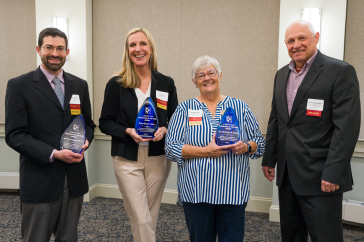
Since winning a prestigious Early CAREER award from the National Science Foundation in 2016, Harish Vashisth has accelerated his career success.
The latest example: a $1.8 million grant from the National Institutes of Health (NIH) that will further molecular research to better understand drug interactions at the cellular level. It could help lead to the development of new targeted drugs to treat widespread metabolic, growth, neurological and visual disorders including diabetes and cancer.
The NIH Maximizing Investigators' Research Award (MIRA) is a competitive award given to established investigators and early stage investigators — within ten years of earning a PhD. — and is designed to provide flexibility to researcher labs and give investigators the opportunity to change direction during their research depending on findings.
“This is an exciting opportunity to support some of our preliminary research that showed promise in new protein drug targets involved in several diseases.”
“This is an exciting opportunity to support some of our preliminary research that showed promise in new protein drug targets involved in several diseases,” says Vashisth, associate professor of chemical engineering.
Vashisth and his team will build on previous research in using computational techniques combined with experimental data to explore new and more suitable stages in the signaling cycle of a cell protein to target drug interventions. The grant will also help upgrade the Premise Supercomputer in the Reasearch Computing Center housed in Morse Hall.
One of the studies will focus on better understanding the folding and binding mechanisms of novel peptides, a short string of amino acids that are building blocks of proteins and perform biological functions. Researchers will look at how they affect cell surface receptor proteins, part of the tyrosine kinase family, to signal responses within the cell. Small peptides can fold and bind to the receptor and mimic the normal physiological effects of natural peptides. The goal is to understand the folding and binding and ultimately find drugs to work around the fold.
“Imagine a cell as a flexible bag with the outer surface as the cell membrane containing proteins that act as gate keepers to communicate, or sense, specific conditions outside the cell that in turn trigger a cascade of signaling inside the cell,” says Vashisth.
Their second research project will take an unconventional approach to target protein-protein interactions in proteins inside the cell, part of the G-protein coupled receptor family, that are important in touch, smell and sight and are implicated in many diseases. This work would create new small molecule drugs that would cross inside the membrane rather than bind to an outside receptor. These drugs would be synthetic and not naturally occurring.
“I want to credit Kathy Cataneo and her team at UNH research office and the leadership team of the NIH Center of Integrated Biomedical and Bioengineering Research (CIBBR) at UNH for supporting our preliminary studies and providing an excellent mentorship environment,” says Vashisth. “The pilot awards were helpful in putting together a stronger application and securing this NIH MIRA award.”
The NIH MIRA provides support for the research in an investigator's laboratory that falls within the mission of National Institute of General Medical Sciences (NIGMS). The goal of MIRA is to provide investigators with greater stability and flexibility, allowing them to pursue new research directions as opportunities arise, thereby enhancing scientific productivity and the chances for important breakthroughs. The program helps distribute funding more widely among the nation's highly talented and promising investigators. MIRA grants are generally for five years, for both established investigators and early stage investigators.
-
Written By:
Robbin Ray ’82 | UNH Marketing | robbin.ray@unh.edu | 603-862-4864

















































